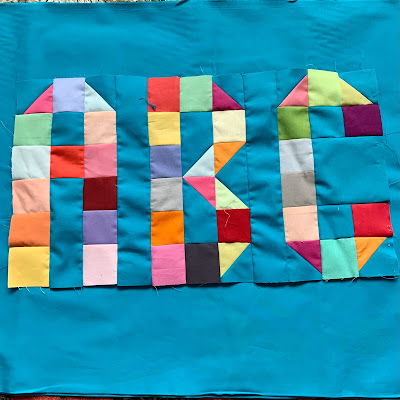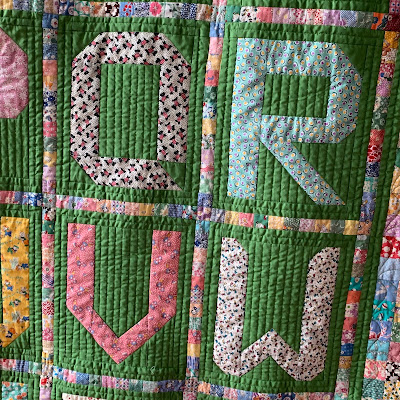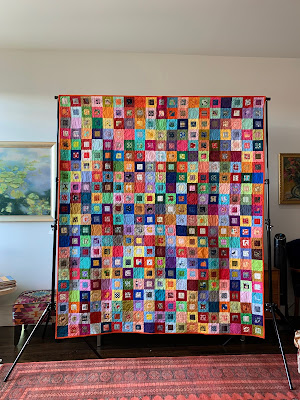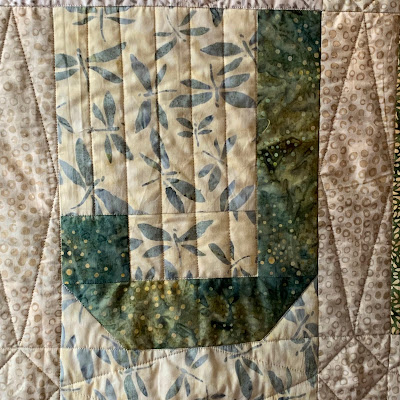91 by 78 inches
Thirteen is made from my 1 1/2 by 2 1/2 inch rectangles bin and my 1 1/2 inch squares bin and is so named because the block finishes 13 inches.
I used the darker and medium scraps making sure to add some brights and lights.
The design is heavily influenced by the fabulous Tonya Riccui's fabulous Lego quilt.
Tutorial showing antique quilt inspiration: http://lazygalquilting.blogspot.com/2011/08/lego-tutorial.html
Finished quilt named Ellis Island: https://lazygalquilting.blogspot.com/2011/11/ellis-island.html
Tonya using varying lengths of fabric and has a 10 inch block.
Why 13 inches?
The block needs to be an odd number in size to allow for the staggered piecing. 9 and 11 inches didn't seem to show the movement I wanted in setting blocks together. I discovered 13 inches was as far as I could sew non-nesting rows without needing pins.
So 13 it is.
Each block has a 78 rectangles and 13 squares
Sew the rectangles into 26 pairs, add a third rectangle, sew these into 13 sets of six, and add a square to the end to make a row unit
Press towards the square.

Turn one row unit opposite of the other. I feed the pair into the machine with the small square first of the top row unit.
Sew row units into pairs, then into fours.
I press these row units down.
Sew three of these 4-units together
Again press down
Add a one row unit
It now measures 13 inches finished (13 1/2 inches unfinished).
Make sure the top and bottom left corners have a square instead of a rectangle.
Press all seams down.
Rotate the blocks and sew together, in pairs, keeping the orientation as pictured. Sew into pairs with the rectangles in vertical orientation on top. The seams are pressed in a way that aids with nesting. I found using an awl or seam ripper to be very helpful in feeding the small pieces and sweeping the underside seam allowances in the correct direction.
In laying out I find it helpful to have the back sides of the blocks showing so the pressing is evident. One miss-turned block can cause issues (speaking from experience).
NOTE: looking at your completed block it will likely not look square. This is due to the accordion effect of the narrow rows. If your sewing was consistent, they will fit.
IF NOT, use the "Plan B" setting I'll describe below.
 |
| From the back showing block orientations |
I set these 6 by 7 blocks to finish 78 by 91 inches.
PLAN B setting:
Keep block with horizontal or vertical orientation, flipping blocks so they will nest to next block. The accordion affect will still happen, but will not distort the quilt top.
The rows will visually keep straight across the quilt.
This is a pleasing setting and I may experiment with this in neutrals. |
| plan B horizontal |
 |
| plan B vertical |
SO, for 42 blocks:
3,276 rectangles
sewn into 1092 three patches
sewn into 546 six patches
546 squares
add a square to each row
Press each row towards the square patch
546 rows
Set aside one row for each block, so 42 rows
Sew remaining 504 rows into 252 pairs, these into 126 fours, these into 42 blocks, add the set aside rows, and end up with 42 final blocks!
(the math may be off on this...)
Press each block with the seams towards the bottom
Decide if you are going with Plan A or Plan B and lay out the blocks accordingly.
Sew into pairs
Lay out 7 by 6 blocks
Everything nests!
My adaptation of Tonya's design--use my changes at your pleasure.






















































